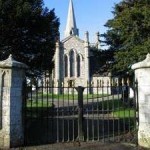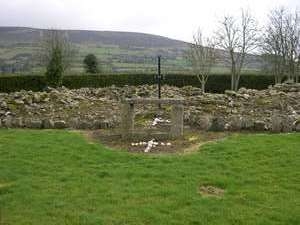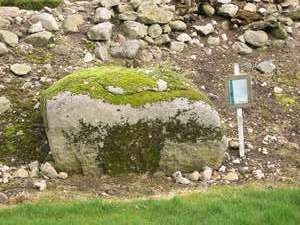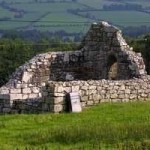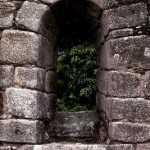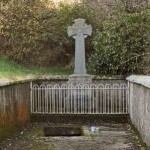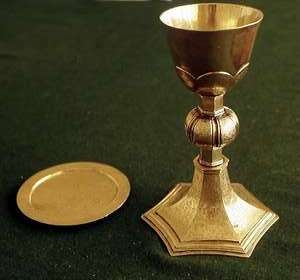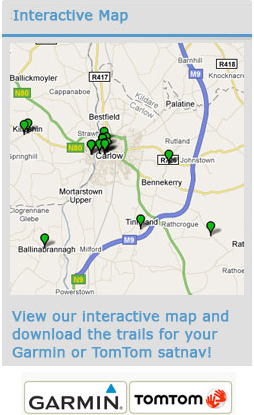Sites
Lorum – Leamhdhroim – Ridge or Long Hill of the Mallows
5. Church of Ireland church – Evidence of three different churches can be found on the site at Lorum. The nineteenth-century seven-bay church stands on elevated ground in a striking setting about 3.5 km from the River Barrow. It was built about 1838 to the design of Frederick Darley who also designed the gate piers which reflect the detailing of the church. The fine, west tower with spire was added in 1862 along with a vestry. It is built of granite ashlar and has well-detailed Gothic revival windows.
The interior retains its stone pulpit, wall monuments, stained glass windows, gallery and later timber-sheeted coved ceiling. Closeby are the remains of an eighteenth-century church while to the south and east of this building are the barely discernible traces of a much earlier church.
 Open: Sunday 10.15 a.m. – 12.30 p.m. or by appointment. T: 087-2270929/059-9775179
Open: Sunday 10.15 a.m. – 12.30 p.m. or by appointment. T: 087-2270929/059-9775179
Admission: Free
Parking: Yes
Church of Ireland church
Church of Ireland church
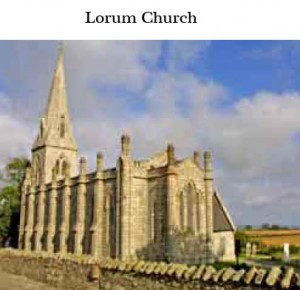 Church of Ireland church Evidence of three different churches can be found on thesite at Lorum. The nineteenth-century seven-bay church stands on elevated ground in astriking setting about 3.5 km from the River Barrow. It was built about 1838 to the designof Frederick Darley who also designed the gate piers which reflect the detailing of thechurch. Close by are the remains of an eighteenth-century church while to the south andeast of this building are the barely discernible traces of a much earlier church.
Church of Ireland church Evidence of three different churches can be found on thesite at Lorum. The nineteenth-century seven-bay church stands on elevated ground in astriking setting about 3.5 km from the River Barrow. It was built about 1838 to the designof Frederick Darley who also designed the gate piers which reflect the detailing of thechurch. Close by are the remains of an eighteenth-century church while to the south andeast of this building are the barely discernible traces of a much earlier church.Ballinree – Baile an Fhraoigh – Town of the Heath
6. Templemoling Cemetery. This peaceful site, in a beautiful landscape setting and enclosed by a well defined circular hedge contains the ephemeral remains of an early church site associated with St. Moling. One can also find here a stone reputed to show the footprint of St. Finian. When one visits the site it is easy to understand why early Christians would have drawn spiritual solace from this place of isolated contemplation. The raised, rubble-strewn area in the centre may preserve the outline of a rectangular church. The modern cross and altar demonstrate that the spiritual ethos of the site is appreciated into the twenty-first century.
Admission: Free
Parking: Yes
Templemoling Cemetery
Templemoling Cemetery
Killoughternane – Cill Uchtarnáin – Church of Fortiarnán (Fortchern)
7. St. Fortiarnán’s church.
Against the backdrop of the Blackstairs Mountains stand the remains of this diminutive rectangular church which dates back to the tenth or eleventh century. It is testament to the building skills of these early stone masons that all four walls are still intact almost one thousand years after they were first built.
Known as the ‘white church’, it is associated with St. Fortiarnán (Fortchern) who was a disciple of St. Loman of Trim, one of the companions of St. Patrick. Fortiarnán left his native Meath and travelled down to the kingdom of Uí Dróna where he founded a monastic community at Killoughternane. St. Fortiarnán’s monastery has been described as one of the earliest missionary schools in Ireland and among those who studied here was St. Finian. After Killoughternane, Finian went to St. David’s monastery in Wales before returning to found the famous monastery at Clonard, Co. Meath.
Traces of a circular enclosure survive around the diminutive church which was built of local hammer-dressed granite. There are antae at both the east and west ends. The church was entered through a lintelled doorway in the west wall and the interior was lit by a round arched window in the east wall above the altar. There may have been another window in the now ruined south wall. There is a small square baptismal font inside the structure.
Don´t miss 8. St. Fortiarnán’s Holy Well in the field across the road from the church. The well, which has been recently restored, has been visited through the centuries. According to local history, “there was more than a newspaper could hold of cures of people who came from county Wexford across the mountains”. In the nineteenth century a local woman cleaning the well found a chalice and paten. These artefacts date to the late sixteenth century and may have been hidden in the well in penal times by a priest who was celebrating open-air masses nearby.
Admission: Free
Parking: Yes
